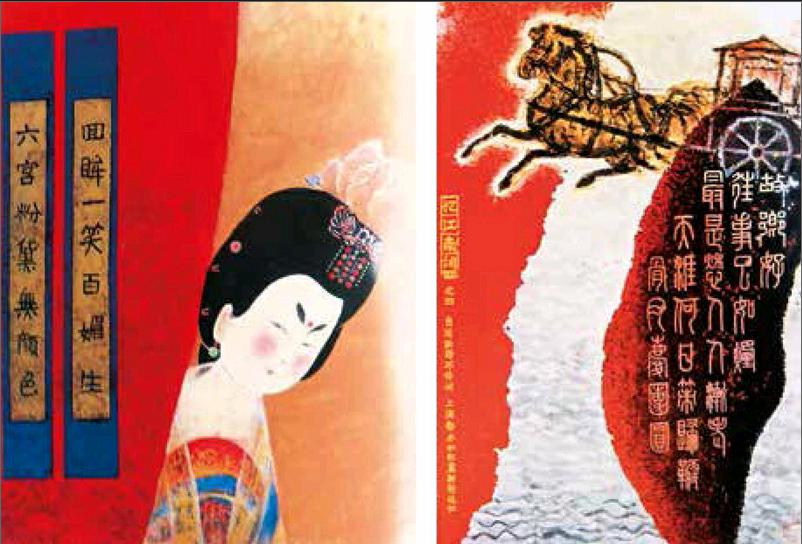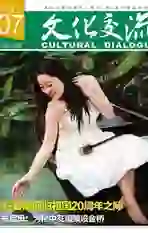余秋雨推崇都冰如
2017-07-24朱明尧
朱明尧


余秋雨先生作为一位著名作家和学者,当红之始是20世纪九十年代,至今仍长盛不衰。他最擅长的文体是中长篇的散文随笔,知识渊博,才华横溢,文笔优雅而文史底蕴丰厚,读之感觉到他的作品不但揭示了中国文化深厚的内涵,而且也为当代散文领域提供了崭新的范例。余秋雨1946年8月出生于浙江余姚(现慈溪)。我在拜读他的《文化苦旅》《山居笔记》和《霜冷长河》等集子之余,曾企望他有缘机能写写海宁的人文胜迹或人事流风。
这种文化期望竟然实现了。1996年10月2日,上海《文汇报·笔会》上刊登了秋雨先生的文章:《色彩还在辉耀——〈都冰如画集〉序》。都冰如(1903-1987)先生,为海宁市袁花人,作为一位画家——综合艺术家,他著名于沪上是从上世纪三十年代开始的。余秋雨在《都冰如画集》序言中写道:“……淼淼六十余年,都冰如先生创作了难以计数的广告设计、橱窗布置、年画、儿童画宣传画。不妨说,在二十世纪,一个对生活中的审美符号稍有关注的中国文化人,几乎不可能没有遇到过都冰如先生的创造。都冰如先生既是一个面向社会的工艺美术家,又是一位从事纯欣赏艺术的著名美术家,他的高层文化素质和美学修养,孕育了他把金石、书画、诗词熔于一炉的独特的艺术风格,使他得以奉献出让人耳目一新的文化美术巨著,例如他以白居易、苏轼、文天祥的诗意为题材的诗画,便生动地表现出都先生胸中一直涌动着一种高贵的文化激动。看到这部分作品,我们终会明白这位美术家有一个多么深邃蕴藉的内在结构,外,可以抚摸现代街市;内,可以沟通千古精魂,这总是真正的大家风范。正是由于这个原因,都冰如先生即使在兵荒马乱的年代也被很多人牵挂着……”在这篇不足两千字的序文中,秋雨先生通篇从艺术感悟落笔,从审美认识延伸,从精神境界上升华,读来生动传神。
拜读了余秋雨先生这篇美文后,我一是想让它为更多的海宁人所赏读,能从中知晓都冰如先贤的艺术贡献,所以以复印件推荐给《海宁日报》副刊,发表于1996年10月25日。二是想能拜读到《都冰如画集》这部书及有关史料。但都老的遗属之通讯地址遍找无着,最后想到试着相烦于余秋雨先生。
贸然致函秋雨先生表达求助代为联系都冰如家属之愿。大约只一周时间,即收到了他的回信:
明尧先生:来信收悉,感谢您的好意。可惜《海宁日报》在转载拙文时删掉了最后一段中的一个让我真正动感情的‘文眼,于是也改变了这篇序言的性质,变成了一篇普通的评论,而我是从不写评论的。此事颇有遗憾。
都冰如先生的家属,我并不认识,是他们通过几层外地亲友的托请,才找到我写序言。画集由上海远东出版社出版(上海冠生园路393号,邮编200233),责任编辑是周亚平、邵红,可与他们联系。
匆此簡复。即颂文安 余秋雨
1996.11.30
秋雨先生平易近人,热情助人,未有某些“大家”的架子,对着我求沟通联系渠道的要求,将出版社的地址、邮编及责任编辑的姓名详实相告。对此,我甚为感动。
由于秋雨先生作了中介,接着我去信远东出版社周、邵二位编辑,承他们回信,告知我关于都冰如先贤的女儿叫都安,又告知了她府上的地址、邮编和联系电话。与都安女士联系后,她分次寄给了我《都冰如画册》和印上画作的年历,以及多份都冰如艺术史料打印稿。经过欣赏、研究,我应约撰写了《“综合艺术家”都冰如》的人物随笔,发表于1996年12月25日《浙江日报》的副刊上;后又以不同的视角和资料分别于《嘉兴日报》和《美术报》上写发了关于都冰如艺术成就及其鲜明风格的文章,并分别附刊半版左右他的书画作品。
幸有秋雨先生的热忱中介和都安女士的浓郁乡情,我知悉了都冰如先贤的出身家庭为书香人家,他的伯父都俞是清末民初浙江的一位著名画家……又知道了抗日战争前沪上举办“都冰如画展”时,由于右任、徐悲鸿、潘天寿、陈之佛、吕凤子和丰子恺等11位人士联名“同启”的200余字介绍文章中称:“海宁都冰如先生,……早岁沉酣绘事,精研六法,举凡国画、西画、图案、篆刻,靡不窥览……采各派之长,冶金石书画于一炉,抒情寄意,创造一新型综合艺术……”还知晓了冰如先贤是位与时俱进的美术家,新中国成立后五十余岁时,他加入了中国美术家协会,他的一幅年画创作《和平之春》被选登在国庆十周年那天的《人民日报》上;他晚年设计创作了大型壁画《画堂春暖》,以工艺图案和碑刻相结合的方法创作,陈列于上海宾馆“嘉会堂”大厅正中;他成了上海市文史馆馆员,上海市政协第四、五届委员……
海宁都冰如先贤的艺术影像所以能在20世纪末叶得到较广泛的传播和弘扬,余秋雨先生的序文,以及他对都氏后人跟故乡的联系起到了关键性的作用。
Du Bingru (1903-1987) was a native of Haining, a city in northern Zhejiang Province. He started as a pop artist in Shanghai in the 1930s. In his career, he created numerous advertisements, New Year paintings, cartoons and drawings for children, designed shop window displays. Those who take interest in the 20th-century Chinas culture cant miss the artworks he created. They were everywhere at least in Shanghai, one of the biggest cities of the country. In his spare time, he painted artistically. Among his artworks are paintings featuring historical celebrities. He was a man of poetry, seal engraving, and painting.
I had known about this artist of our hometown long before I read about him in an article in a Shanghai-based newspaper published on October 2, 1996. The article in less than 2,000 words was written by Mr. Yu Qiuyu, an essayist of national renown. The article gave a brief introduction to the artist and commented on his cultural significance. I was excited and thought it necessary to let more fellow Haining people know about the native artist. So I sent a copy of the newspaper article to the Haining Daily. Mr. Yus article came out on October 25, 1996. After reading Mr. Yus essay about a collection of Du Bingrus artworks, I wished to read that collection and know more about the artist. I hit upon the idea of contacting the relatives of the artist. I tried and failed. Then I took the liberty of writing Mr. Yu a letter to see if he could set up a contact on my behalf.
Yu wrote back a week later. He said in the letter: “Thank you for sending the copy to Haining Daily, but regretfully, the newspaper deleted a key phrase in the last paragraph. The deletion turned my foreword to the collection into a general commentary. I never write commentaries. The deleted version was regretful.”
He explained that he didnt personally know the relatives and family members of Du Rubing and that the request for him to write a foreword came through a convoluted network of common friends. He gave me the address of the publisher and the names of the editors and advised me to contact the editors for information.
The editors introduced me to Du Bingrus daughter, who sent me books and copies of documents and artworks. After studying and appreciating the material, I wrote an essay on Du Bingru. The essay was printed in the literary column of Zhejiang Daily on December 25, 1996. Shortly afterwards, I wrote two other essays about Du Bingru and his artist career from other perspectives. The two were respectively published in Jiaxing Daily and Art Weekly, each accompanied by half a page of his artworks.
Du Bingru came from a family of artists and scholars. Du Yu, an uncle of his, was a prominent artist in the decades that spanned the end of the Qing Dynasty and the founding of the Republic of China. Du Bingru himself held a solo art exhibition in Shanghai before the Chinese War of Resistance against Japanese Aggression started in the early 1930s. Eleven celebrated artists and scholars such as Yu Youren, Xu Beihong, Pan Tianshou, Chen Zhifo, Lyu Fengzi and Feng Zikai jointly wrote a short foreword for the exhibition. One of his New Year Paintings, titled , was reprinted in Peoples Daily in celebration of the tenth anniversary of the founding of the Peoples Republic of China in 1959. Shanghai Hotel presents , a tremendous wall painting of his, in the lobby. He was a member of Shanghai Research Institute of Culture and History and a deputy of CPPCC Shanghai Congress.
Haining is proud of Du Bingru, a local celebrity whose comeback into the public awareness toward the end of the 20th century is largely due to Yu Qiuyus foreword and Dus familys kindness and generosity.
